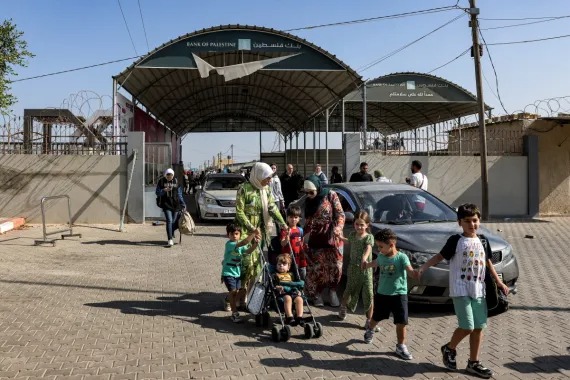The Rafah border crossing connecting the beleaguered Gaza Strip to Egypt has reopened its gates. This critical lifeline, which has been closed for an extended period due to the Israel-Hamas conflict, has now allowed more than 500 foreign nationals, dual citizens, and injured Palestinians to leave the war-torn enclave. This long-anticipated move aims to provide reprieve to those caught in the crossfire and deliver essential aid to a region gripped by crisis.
The Rafah Crossing, which holds immense strategic importance in the region, had been locked shut since the eruption of the Israel-Hamas war. For the first time in weeks, the Gaza Borders and Crossings Authority has announced its reopening.
Foreign Nationals and Dual Citizens Given Green Light for Departure
More than 500 foreign nationals and dual citizens, residing within the Gaza Strip, will now have the opportunity to leave the enclave, according to the Gaza Borders and Crossings Authority. The authority has released an official list of those permitted to cross, urging them to make their way to the border on Wednesday at 7 a.m. local time (05:00 GMT).
This much-awaited development will bring relief to individuals with international ties who have been stranded in the war-torn region, separated from their home countries and loved ones. The reopening of Rafah Crossing presents a glimmer of hope for those seeking safety and stability beyond the conflict-ridden Gaza Strip.
Injured Palestinians to Receive Vital Medical Treatment in Egypt
In addition to the foreign nationals, the reopening of Rafah Crossing will enable dozens of injured Palestinians in dire need of medical treatment to depart the Gaza Strip. With medical facilities and resources strained within the enclave, this opportunity could be a lifeline for those suffering from injuries sustained during the conflict.
Ambulances stand ready on the Egyptian side of the crossing, prepared to transport the wounded and sick to hospitals in Egypt. The departure of these patients not only provides them with the chance for essential medical care but also eases the burden on Gaza’s healthcare system, which has been overwhelmed by the influx of casualties.
Hope and Aid Trickle Through, But Challenges Persist at Rafah Crossing
While convoys of urgently needed aid have been trickling into Gaza through the Rafah Crossing since the conflict began, the passage of individuals had remained restricted until now. As the gates reopened, queues quickly formed at the terminal, with individuals eager to cross and escape the crisis. Once inside the terminal, long lines extended at crossing booths as authorities conducted passport and document checks.
Ambulances, stationed on the Egyptian side of the border, continue to wait for the green light to transfer the injured. Meanwhile, trucks laden with aid are also lined up on the Egyptian side of the crossing. This development highlights both the urgency of providing aid to the region and the ongoing challenges in ensuring a smooth and efficient flow of people and resources through the crossing.
The zone surrounding the terminal has not been spared from the ravages of conflict, having suffered damage during Israeli air raids on Gaza, causing tragic loss of life and injuries. The toll from the October 7 attacks, as reported by Israeli authorities, surpasses 1,400 casualties, with the majority being civilians. Additionally, over 240 individuals have been taken captive in the wake of the conflict.
Among those being allowed to leave for medical treatment in Egyptian hospitals are more than 15,000 wounded in Israeli air raids. Gaza’s Ministry of Health asserts that these raids have claimed the lives of over 8,500 people, with women and children constituting two-thirds of the casualties.
As Rafah Crossing reopens, it serves as a beacon of hope for those seeking safety and vital medical care beyond the borders of the Gaza Strip. Nevertheless, the challenges and suffering wrought by the ongoing conflict continue to cast a long shadow over the region, underscoring the urgent need for a sustainable resolution to the crisis.
















